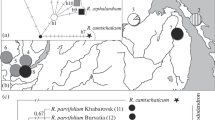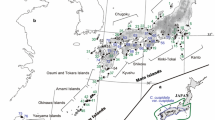Abstract
Toxicodendron succedaneum: (L.) Kuntze is a tree cultivated for the production of sumac wax, which is extracted from the mesocarp. There are several hypotheses regarding the origin of T. succedaneum on mainland Japan. In this study, the geographical distribution of genetic variation in 13 wild populations on Honshu, Shikoku, Kyushu, and Ryukyu Islands, Japan was investigated and compared with that of individuals from continental Asia. Seven chloroplast DNA haplotypes of T. succedaneum were observed in Japan and could be divided into three lineages based on relatedness between haplotypes. One of these lineages was also observed in continental Asia, and the others were genetically distant from the haplotypes that originated on the continent, with one considered to have originated on the Ryukyu Islands, and the other on mainland Japan. The genetic diversity of both chloroplast and nuclear DNA was lower in populations from Ryukyu Islands than in populations from mainland Japan. Bayesian clustering based on nuclear genotypes showed a clear difference between the groups from Ryukyu Islands and mainland Japan. Based on approximate Bayesian computation analysis of polymorphic data for both genomes, it was inferred that wild populations of T. succedaneum on mainland Japan consist of both lineages with natural distribution on mainland Japan and those introduced from Ryukyu Islands and continental Asia.






Similar content being viewed by others
References
Barrett SCH (1998) The reproductive biology and genetics of island plants. In: Grand PR (ed) Evolution on islands. Oxford University Press, Oxford, pp 18–34
Barton NH (1998) Natural selection and random genetic drift as causes of evolution on islands. In: Grand PR (ed) Evolution on islands. Oxford University Press, Oxford, pp 102–123
Beaumont MA (2010) Approximate Bayesian computation in evolution and ecology. Annu Rev of Ecol Evol Syst 41:379–405
Clement M, Posada D, Crandall K (2000) TCS: a computer program to estimate gene genealogies. Mol Ecol 9:1657–1660
Csilléry K, François O, Blum MGB (2012) abc: an R package for approximate Bayesian computation (ABC). Meth Ecol Evol 3:475–479
Don RH, Cox PT, Wainwright BJ, Baker K, Mattick JS (1991) ‘Touchdown’ PCR to circumvent spurious priming during gene amplification. Nucleic Acids Res 19:4008
Dussert Y, Snirc A, Robert T (2015) Inference of domestication history and differentiation between early- and late-flowering varieties in pearl millet. Mol Ecol 24:1387–1402
El Mousadik A, Petit RJ (1996) High level of genetic differentiation for allelic richness among populations of the argan tree [Argania spinosa (L.) Skeels] endemic to Morocco. Theor Appl Genet 92:832–839
Estoup A, Jarne P, Cornuet J-M (2002) Homoplasy and mutation model at microsatellite loci and their consequences for population genetics analysis. Mol Ecol 11:1591–1604
Evanno G, Regnaut S, Goudet J (2005) Detecting the number of clusters of individuals using the software STRUCTURE: a simulation study. Mol Ecol 14:2611–2620
Excoffier L, Foll M (2011) fastsimcoal: a continuous-time coalescent simulator of genomic diversity under arbitrarily complex scenarios. Bioinfomatics 27:1332–1334
Excoffier L, Lischer HE (2010) Arlquin suite ver 3.5: a new series of programs to perform population genetics analyses under Linux and Windows. Mol Ecol Resour 10:564–567
Excoffier L, Estoup A, Cornuet J-M (2005) Bayesian analysis of an admixture model with mutations and arbitrarily linked markers. Genetics 169:1727–1738
Falush D, Stephens M, Pritchard JK (2003) Inference of population structure using multilocus genotype data: linked loci and correlated allele frequencies. Genetics 164:1567–1587
Fiorentino F, Magli MC, Podini D, Ferraretti AP, Nuccitelli A, Vitale N, Baldi M, Gianaroli L (2003) The minisequencing method: an alternative strategy for preimplantation genetic diagnosis of single gene disorders. Mol Hum Reprod 9:399–410
Garza JC, Williamson EG (2001) Detection of reduction in population size using data from microsatellite loci. Mol Ecol 10:305–318
Goudet J (2001) FSTAT, a program to estimate and test gene diversities and fixation indices (version 2.9.3). Available from http://www2.unil.ch/popgen/softwares/fstat.htm, March 25, 2017
Grivet D, Heinze B, Vendramin GG, Petit RJ (2001) Genome walking with consensus primers: application to the large single copy region of chloroplast DNA. Mol Ecol Notes 1:345–349
Hiraoka K, Tomaru N (2009) Genetic divergence in nuclear genomes between populations of Fagus crenata along the Japan Sea and Pacific sides of Japan. J Plant Res 122:269–282
Hiraoka Y, Watanabe A (2010) Development and characterization of microsatellites, clone identification, and determination of genetic relationships among Rhus succedanea L. individuals. J Jpn Soc Hortic Sci 79:141‒149
Hiraoka Y, Watanabe A (2011) Comparisons of chloroplast haplotypes in Toxicodendron succedaneum (L.) Kuntze among local cultivars and candidates for superior trees in Japan and wild individuals from the Asian Continent and Okinawa Island. J Jpn For Soc 93:200‒204 (in Japanese with English summary)
Iwatsuki K (1999) Anacardiaceae. In: Iwatsuki K, Boufford DE, Ohba H (eds) Flora of Japan, vol. IIc. Kodansha, Tokyo, pp 58–59
Kalinowski ST (2004) Counting alleles with rarefaction: private alleles and hierarchical sampling designs. Conserv Genet 5:539–543
Kalinowski ST (2005) HP-RARE 1.0: a computer program for performing rarefaction on measures of allelic richness. Mol Ecol Notes 5:187–189
Katsuta M (1998) Rhus Linn. (Sumac). In: Katsuta M, Mori T, Yokoyama T. Seed of forest tree in Japan [*in Japanese, the book title is a tentative translation by the author], Society of Forest Tree Breeding, Tokyo, pp 222–227
Masaki Y (1938) Toxicodendron succedaneum and sumac wax in Japan [*in Japanese, title is a tentative translation by the author]. Meibundo, Tokyo
Mogensen HL (1996) The hows and whys of cytoplasmic inheritance in seed plants. Am J Bot 83:383–404
Muse SV (2000) Examining rates and patterns of nucleotide substitution in plants. Plant Mol Biol 42:25–43
Nei M (1987) Molecular evolutionary genetics. Columbia University Press, New York
Nie Z, Sun H, Meng Y, Wen J (2009) Phylogenetic analysis of Toxicodendron (Anacardiaceae) and its biogeographic implications on the evolution of north temperate and tropical intercontinental disjunctions. J Syst Evol 47:416–430
Noguchi K (1977) Development of Toxicodendron succedaneum cultivation and dispersion of elite cultivars in Japan [*in Japanese, title is a tentative translation by the author]. Rekishigaku Chirigaku Nenpo 1:1–24
Petit RJ, Bodenes C, Ducousso A, Roussel G, Kremer A (2004) Hybridization as a mechanism of invasion in oaks. New Phytol 161:151–164
Plummer M, Best N, Cowles K, Vines K (2006) CODA: convergence diagnosis and output analysis for MCMC. R News 6:7–11
Potts BM, Reid JB (1988) Hybridization as a dispersal mechanism. Evolution Int J org Evolution 42:1245–1255
Prichard JK, Stephens M, Donnelly P (2000) Inference of population structure using multilocus genotype data. Genetics 155:945–959
R Core Team (2016) R: a language and environment for statistical computing. R Foundation for Statistical Computing, Vienna
Rozen S, Skaletsky HJ (2000) Primer3 on the WWW for general users and for biologist programmers. In: Krawetz S, Misener S (eds) Bioinformatics Methods and Protocols: Methods in Molecular Biology. Humana Press, Totowa, pp 365–386
Sakaguchi S, Qiu Y-X, Liu Y-H, Qi X-S, Kim S-H, Han J, Takeuchi Y, Worth JRP, Yamasaki M, Sakurai S, Isagi Y (2012) Climate oscillation during the Quaternary associated with landscape heterogeneity promoted allopatric lineage divergence of a temperate tree Kalopanax septemlobus (Araliaceae) in East Asia. Mol Ecol 21:3823–3838
Shiraishi S, Watanabe A (1995) Identification of chloroplast genome between Pinus densiflora Sieb. et Zucc. and P. thunbergii Parl. based on the polymorphism in rbcL gene. J Jpn For Soc 77:429–436 (Japanese with English summary)
Tamaki I, Kuze T, Hirota K, Mizuno M (2016) Genetic variation and population demography of the landrace population of Camellia sinensis in Kasuga, Gifu Prefecture, Japan. Gen Res Crop Evol 63:823–831
Weir BS, Cockerham CC (1984) Estimating F-statistics for the analysis of population structure. Evol Int J org Evol 38:1358–1370
Zhai S-N, Comes HP, Nakamura K, Yan H-F, Qiu Y-X (2012) Late Pleistocene lineage divergence among populations of Neolitsea sericea (Lauraceae) across a deep sea-barrier in the Ryukyu Islands. J Biogeogr 39:1347—1360
Acknowledgements
We are grateful to Drs. M. Suzuki and T. Tanaka for sampling the materials used in this study. We also thank Mr. M. Ogata, Mr. K. Miyahira, the members of the Kyushu Regional Breeding Office (Forest Tree Breeding Center), Fukuoka Prefecture and Chiba Prefecture, for their assistance in the field. We also thank Dr. K. Mishima and the members of the Forest Tree Breeding Center for their support with experiments. We also thank Drs. S. Shiraishi, M. Tamura, and M. Takahashi for helpful advice.
Author information
Authors and Affiliations
Corresponding author
Ethics declarations
Conflict of interest
The authors declare that they have no conflicts of interest.
Funding
This research was supported by funds from the ordinary budget of the Forestry and Forest Products Research Institute (FFPRI).
Electronic supplementary material
Below is the link to the electronic supplementary material.
Rights and permissions
About this article
Cite this article
Hiraoka, Y., Tamaki, I. & Watanabe, A. The origin of wild populations of Toxicodendron succedaneum on mainland Japan revealed by genetic variation in chloroplast and nuclear DNA. J Plant Res 131, 225–238 (2018). https://doi.org/10.1007/s10265-017-0992-7
Received:
Accepted:
Published:
Issue Date:
DOI: https://doi.org/10.1007/s10265-017-0992-7




